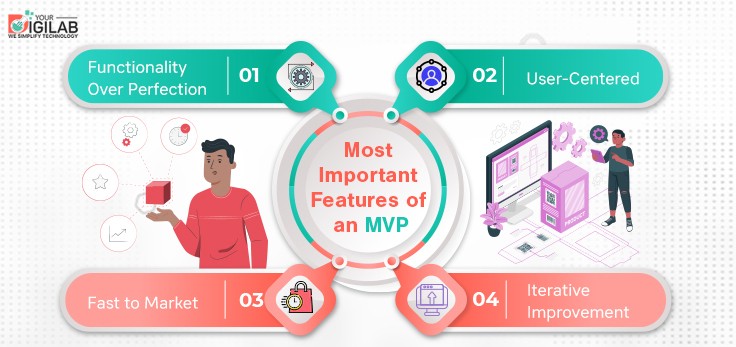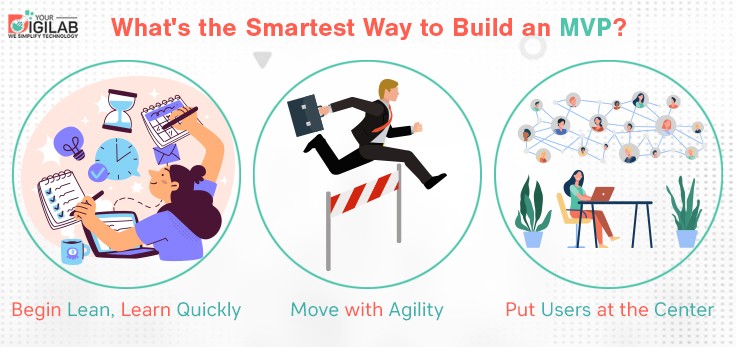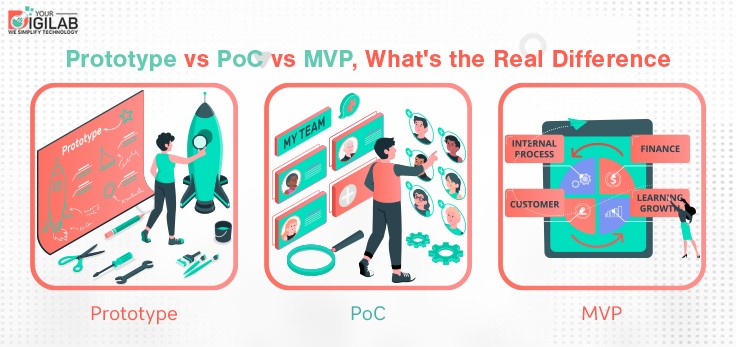By John Fernandes modified Jun 17, 2025
~ 3 minutes to read
Building the perfect website sounds great, until you realize it could cost you months of work, ballooning budgets, and missed market opportunities. In fact, studies show that launching too late can be just as dangerous as launching too soon.
Now, imagine taking a smarter route, the MVP website. In web development, a Minimum Viable Product (MVP) refers to the simplest version of a product that delivers core functionality, allowing teams to gather early user feedback for future improvements.
Considering that 90% of startups miss the mark, usually by overbuilding or guessing at what users want, an MVP lets you flip the odds. You launch sooner, spend less, and learn faster.
Just ask Dropbox, Airbnb, or Facebook. They all started with MVPs that were far from perfect, but powerful enough to launch their journey to the top.
So, how do you actually go from idea to MVP website, without the overwhelm? In this guide, we’ll walk you through every step, from figuring out your must-have features to picking the tech tools that fit your vision.
So, let’s get started!
MVP stands for Minimum Viable Product. MVP web development is the minimal web application or website that only has the essential features necessary to solve a given issue or serve initial users. Businesses usually utilize MVP web development services to create lean digital products, concentrating on actual user needs and early feedback.
It's a tactical strategy employed to test an idea with speed and affordability before allocating more time and resources.

Functionality Over Perfection: It is centered around providing the critical functionality without additional features, polish, or design fluff.
User-Centered: It is designed to serve the needs of early adopters who can offer suggestions for enhancement.
Fast to Market: The MVP is created and released quickly to validate the concept in a real-world context.
Iterative Improvement: Developers iterate based on feedback from the users and add features step by step.
Prior to jumping headfirst into a full-blown web development project, introducing a Minimum Viable Product (MVP) is a game-changer. By developing with just the essentials first, you create the foundation for more intelligent development, minimized risk, and improved long-term success.
These are the essential advantages of creating an MVP website and why it's the best first step on your product path:
Releasing a bare-bones version of your product enables you to go live fast. Rather than taking months to create all the features you can, an MVP puts your central solution in front of users, before long. That means you're addressing actual issues and building momentum early.
Why it matters: Speed is a competitive advantage. While other folks are bogged down in development, you're live and making adjustments already.
By focusing on essential functionality, you reduce up-front costs and don't spend cash on features that may never get used. An MVP lets you try out your idea with minimal resources, making it ideal for lean startups and teams.
Bonus: You can funnel what you save into subsequent versions based on user data, rather than guesses.
Related Read: Website Cost Breakdown
An MVP isn't so much about going fast; it's about learning fast. By releasing an early version of your site, you get to capture feedback from early adopters who will influence the future of your product.
Insight leads to improvement: Knowing what users adore allows you to focus on improvements that are actually important.
An MVP strategy deconstructs the development path into palatable steps. Every iteration is a chance to test assumptions and figure out what succeeds before the next resource commitment. Incremental validation reduces the risk of money and avoids expensive product failures.
Concentrating on a minimal set of features prevents development teams from burning out and keeps them in sync. Clear-cut priorities reduce scope creep, improve communications, and boost morale. It is a lean process that allows for faster decision-making and improved use of time and resources.
The ease of an MVP makes it possible to adopt new trends or regulatory needs quickly. This nimbleness guarantees that the product remains current and compliant in a changing environment, thus minimizing risks of obsolescence or any legal issues.

Developing a minimal viable product (MVP) is the smartest way to validate your idea, reduce risk, and speed up shipping, but which way to go for your app? Here is everything you should know:
The Lean Startup philosophy is about creating a stripped-down version of your product to test your key concept fast. Rather than spending too much time on features that customers might not want, you're collecting real-world feedback early and adapting based on learnings.
Agile development rests on flexibility, brief sprints, and continuous iteration. Agile keeps your MVP flexible, so you can pivot or iterate based on what the market is calling for. Agile teams are quicker to respond, waste less, and create higher-quality products by remaining attuned to user feedback along the way.
Your MVP must be centered on actual user needs. A user-centered approach is one of engaging users from day one, listening, testing, and iterating on their input. IDEO founder David Kelley says it this way: "Fail faster to succeed sooner." The faster you figure out what users actually want, the faster your MVP is a product they'll love.
Need a Clear MVP Roadmap?
Get a step-by-step plan customized to your goals and budget.
Get Free MVP Plan
Building a Minimum Viable Product (MVP) isn't all about racing to market; it's about learning rapidly, checking the validity of your concept, and setting yourself up for future expansion. Here is a step-by-step checklist of best practices to apply when developing your MVP in website development:
Before you ever write one line of code, have a very clear definition of the business problem you're addressing. Who is your MVP for, and what is it solving?
Tip: Your MVP needs to address an actual problem that's still current by the time you craft it; don't pursue ancient trends.
Having established what you are making, enumerate all possible features and sort them out into three categories:
Get your development team to work with you to determine technical viability and prioritize based on sound reasoning. This exercise keeps your MVP lean without sacrificing impact.
Rather than diving into MVP creation directly, begin by creating a Proof of Concept. This allows you to validate the technical and market viability of your concept in a low-risk manner.
Remember: A successful PoC boosts confidence and direction before full-scale development.
Clearly define how you’ll measure the success of your MVP. This keeps your development efforts aligned with business goals.
Pro Tip: Google Analytics, Hotjar, and Mixpanel can provide you with in-depth insights into MVP performance.
Your MVP isn't the finished product; it's the beginning of it. Once launched:
Speed is valuable, but never at the cost of quality.
Bridging the gap between development and a complete launch, MVP validation guarantees you're creating something that people want. It turns out that user-validated startups are 50% more likely to be product-market fit.
Surveys: Brief and targeted surveys elicit better responses. Utilize tools such as Google Forms to collect opinions regarding features, usability, and satisfaction in less than 2 minutes.
Analytics: Monitor what users do. Tools such as UXCam or Google Analytics indicate which features are clicked and where users fall off.
Usability Testing: Observe users using your product. Screen recordings expose confusion, friction, and areas for improvement you may otherwise overlook.
Planning Your MVP Website?
Let’s help you outline features, tech stack, and launch strategy.
Talk to Our Experts!
Ramping up a Minimum Viable Product (MVP) can provide your software concept the speed bump it requires, provided you steer clear of common pitfalls that hinder progress and squander resources.
Here's the smarter way to avoid the pitfalls that many teams often get caught up in:
Mistake: Omitting market research
Fix: Don't guess, know your audience. Begin by testing your idea with actual data. Apply surveys, interviews, and competitor research to verify product demand before writing one line of code. Early discovery informs what your MVP needs to fix, and for whom.
Mistake: Piling too many features
Fix: The goal of an MVP is concentration. Keep your set of features as limited as possible to what's truly necessary. Address one well-defined issue and do it correctly. Resist the urge to wow users with bells and whistles; keep it simple in early creation.
Mistake: Skipping prototyping and early user feedback
Prototypes are your MVP's design. A clickable mockup or visual demo facilitates quick, inexpensive testing. Share it with target users, collect feedback, and iterate. This process saves time and aligns your product with user expectations prior to full-fledged development.
Mistake: Ignoring performance data What gets measured improves. Make analytics part of your MVP to track usage patterns, drop-off points, and engagement. These data inform future priorities and demonstrate what works, or what doesn't.
Mistake: Skipping QA and performance testing
MVPs are about simplicity, not poor quality. Even a basic product needs to work flawlessly. Conduct usability tests, eliminate bugs, and test for cross-device compatibility. A buggy release can prevent early adopters permanently, even if your concept is sound.

As you know, when it comes to app development, three terms often come up: Proof of Concept (PoC), Prototype, and Minimum Viable Product (MVP). Though they may sound similar, each serves a distinct purpose at different stages of your product’s journey. Knowing how and when to use each can save you time, money, and confusion.
A Proof of Concept is your means of responding to one important question: Is this possible? It's a short, technical test to see if your concept is viable from a technology or development point of view.
● Purpose: To check technical feasibility
● Used By: Developmental and technical teams
● Output: A functioning proof that a certain function or technology is viable
● Best For: Innovative or high-risk features where one must first validate before fully developing them
A prototype is an initial visual representation of your app. It's not actually functional; visualize it as a sketch made real through wireframes or mockups. Its main function is to confirm design, layout, and user experience prior to development.
● Purpose: To test and perfect the look and feel of your product
● Tools Used: Figma, Adobe XD, Sketch
● Used By: Designers, product teams, and stakeholders for early feedback
● Best For: Showcasing concepts to gain stakeholder approval before starting development.
An MVP is a working version of your app with minimal core features to fix the central user issue. It's designed to be shipped, tested in the market, and iterated upon based on actual user feedback.
● Purpose: Testing market demand and substantiating the product's fundamental functionality
● Tools Used: Real development frameworks (React, Flutter, etc.)
● Used By: Early adopters and users for hands-on interaction
● Best For: Demonstrating product-market fit with low investment
|
Feature |
PoC |
Prototype |
MVP |
|
Functionality |
Prove technical feasibility |
Non-functional |
Fully functional (basic) |
|
Goal |
Limited or backend only |
Design validation |
Market validation |
|
Audience |
Internal dev team |
Internal teams, testers |
Real users, early adopters |
|
Speed to Build |
Short |
Fast |
Takes longer than prototyping |
|
Development Required |
Technical risk |
No |
Yes |
The price of creating a Minimum Viable Product (MVP) website usually varies between $10,000 and $100,000, based on complexity. The majority of MVPs are on the lower side, but more sophisticated features, integrations, or custom business logic can inflate the price.
|
Component |
Estimated Cost Range |
Details |
|
Basic features & Logic |
$4,000 – $15,000 |
Core functionalities like forms, login, and dashboards |
|
UX|UI Design |
$2,000 – $8,000 |
Wireframes, user flow, and responsive design |
|
Front-end Development |
$3,000 – $15,000 |
User-facing interface, interactive elements |
|
Back-end Development |
$4,000 – $20,000 |
Server-side logic, APIs, databases |
|
User Research & Testing |
$1,000 – $5,000 |
Prototyping, early testing with real users |
|
Security & Compliance |
$1,000 – $5,000 |
SSL, data encryption, GDPR, HIPAA (if needed) |
|
Project Management & QA |
$2,000 – $7,000 |
Planning, communication, and ongoing testing |
Note: The MVP website development cost mentioned above is are estimate. Your MVP web development cost may vary based on specific requirements. To get the precise cost estimate, collaborate with a trusted MVP web development company.
Related Read: Explore the perfect launch strategy for your MVP website.
Build a Budget-Friendly MVP with Yourdigilab
Discover cost-saving strategies without compromising quality.
Get Free MVP Cost Estimate!
Building an MVP typically takes 4 to 12 weeks, but the timeline varies based on product needs, team structure, and technical choices. Below is a detailed breakdown to guide your expectations:
|
Development Phase |
Time Estimate |
Key Activities |
|
Planning & Requirements |
1 week |
Define goals, audience, and features |
|
Design & Prototyping |
1-2 weeks |
UI/UX design, wireframes, prototyping |
|
Core Development |
2–6 weeks |
Build essential features, backend, and frontend |
|
Testing & Iteration |
1–2 weeks |
Bug fixing, user testing, adjustments |
|
Deployment & Feedback Loop |
1 week (ongoing after) |
Deploy MVP, collect real-world feedback |
Many globally recognized companies started with humble MVPs. They focused on solving one key problem, then grew by learning from real users. Here are some of the most iconic Minimum Viable Product Website Examples!
|
Startup |
Initial MVP Idea |
Key Focus |
Result & Evolution |
|
Dropbox |
A simple explainer video showing how file syncing would work |
Gauge user interest without building the full product |
Thousands joined the waitlist, proving demand and attracting investors before coding began |
|
Airbnb |
A basic website renting out space in the founders’ apartment |
Test if people would pay for peer-to-peer lodging |
Early bookings validated the concept, leading to nationwide and then global expansion |
|
Spotify |
A desktop app offering instant music streaming |
Ensure a fast, smooth listening experience |
Positive UX feedback helped them scale quickly and secure music licenses |
|
|
Internal SMS-based tool at a podcasting company (Odeo) |
Allow team members to share quick updates |
Grew organically at SXSW 2007 and evolved into a global microblogging platform |
|
Zappos |
The founder took photos of shoes in local stores and sold them online |
Validate online demand for shoes without holding inventory |
Proved that customers would buy shoes online, leading to a full-fledged e-commerce business acquired by Amazon |
At YourDigiLab, we’re a driven and passionate web development agency committed to transforming ideas into scalable digital products. With over a decade of experience in delivering SaaS MVPs, custom mobile apps, and enterprise-grade web solutions, we’ve become a trusted technology partner for businesses aiming to grow in a digital-first world.
We have an established track record of successfully delivering high-performing digital products that meet our clients' strategic objectives.
Our methodology is rooted in thorough industry expertise, user-experience design, and scalable technology architectures that support long-term scalability and achievement.
Whether introducing a new SaaS MVP or transforming legacy applications, we focus on quality, agility, and quantitative impact.
Let’s Build Your MVP Together
Let us help you build a lean, high-impact MVP that users will love.
Book a free consultation with our experts today.
A fantastic MVP begins with Lean Startup practices, supplements Agile development for adaptability, and always prioritizes the end user.
Start with the central issue you are trying to resolve. Keep to essential features, employ prototyping tools such as UXPin Merge, and receive genuine user feedback early and frequently.
Typically, it takes 4 to 12 weeks to build an MVP based on your website complexity, features, a nd development team.
They let you test your idea quickly, collect real user feedback, and avoid wasting time and money on features nobody wants.
Only the critical features that address the central user problem or meet the main objective must be included. All other things can be added based on user testing and feedback.
Yes. A well-crafted MVP provides a building block for further expansion. After being validated, your site may be added to with new functionality and perfected using actual user feedback.
Start by identifying your core user problem and defining only the essential features needed to solve it. Use rapid prototyping tools and frameworks to develop quickly and gather real user feedback to guide future iterations.
John Fernandes is content writer at YourDigiLab, An expert in producing engaging and informative research-based articles and blog posts. His passion to disseminate fruitful information fuels his passion for writing.